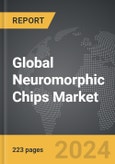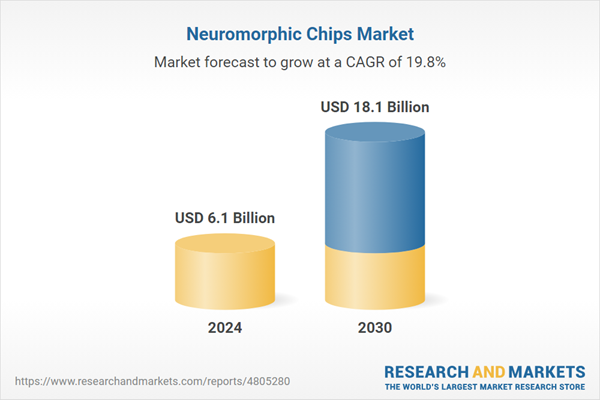The global market for Neuromorphic Chips was valued at US$6.1 Billion in 2024 and is projected to reach US$18.1 Billion by 2030, growing at a CAGR of 19.8% from 2024 to 2030. This comprehensive report provides an in-depth analysis of market trends, drivers, and forecasts, helping you make informed business decisions. The report includes the most recent global tariff developments and how they impact the Neuromorphic Chips market.
The ability of neuromorphic chips to process data in parallel, much like the human brain, makes them ideal for handling complex tasks such as image and speech recognition, autonomous navigation, and brain-computer interfaces. Their low power consumption is especially advantageous for mobile devices, Internet of Things (IoT) applications, and wearable technologies, where battery life is a critical concern. As AI systems evolve, neuromorphic chips are poised to play a major role in accelerating the development of more intelligent and power-efficient machines.
Another important trend is the increasing collaboration between chip manufacturers and AI researchers. Companies like Intel, IBM, and BrainChip are developing neuromorphic processors that can support AI models with high efficiency. These chips are being embedded in a variety of applications, from drones and autonomous vehicles to smart appliances and healthcare devices. The push towards miniaturization and enhanced processing capabilities continues, with neuromorphic chips becoming more scalable and adaptable for various industrial uses.
In healthcare, neuromorphic chips are gaining traction for use in wearable devices, brain-machine interfaces, and robotic surgery tools. They provide the processing power needed for advanced applications such as neural signal processing and prosthetic control, where real-time responsiveness is crucial. Additionally, the rise of AI-powered diagnostics and personalized medicine is driving the demand for neuromorphic chips in medical devices that can analyze patient data more efficiently. The industrial robotics sector is also a major user, where neuromorphic chips enable smarter, more adaptive robots capable of handling complex manufacturing tasks with improved precision.
The advancement of AI and machine learning algorithms, particularly those that mimic the structure of the brain, is also fueling the adoption of neuromorphic chips. As AI systems become more complex, neuromorphic hardware is needed to efficiently execute these models. Additionally, the growing focus on AI in sectors such as healthcare, automotive, and robotics is pushing companies to adopt neuromorphic chips for more responsive and power-efficient solutions. Lastly, the increasing investments in AI research and the development of next-generation computing architectures are expected to drive further innovation and growth in this market.
Segments: Application (Image Recognition, Data Mining, Signal Recognition, Other Applications); End-Use (Consumer Electronics, Automotive, Industrial, Aerospace & Defense, Healthcare, Other End-Uses).
Geographic Regions/Countries: World; United States; Canada; Japan; China; Europe (France; Germany; Italy; United Kingdom; and Rest of Europe); Asia-Pacific; Rest of World.
The analysts continuously track trade developments worldwide, drawing insights from leading global economists and over 200 industry and policy institutions, including think tanks, trade organizations, and national economic advisory bodies. This intelligence is integrated into forecasting models to provide timely, data-driven analysis of emerging risks and opportunities.
Global Neuromorphic Chips Market - Key Trends & Drivers Summarized
What Are Neuromorphic Chips and Why Are They Important?
Neuromorphic chips are specialized microprocessors designed to mimic the structure and function of biological neural networks. These chips are engineered to emulate the brain's efficiency in processing information, enabling highly efficient computations while consuming far less power compared to traditional processors. Neuromorphic chips leverage spiking neural networks (SNNs) and asynchronous processing, allowing them to perform tasks such as pattern recognition, sensory processing, and decision-making much more quickly and with minimal energy consumption. These chips are particularly important in fields like artificial intelligence (AI), robotics, and edge computing, where real-time decision-making is crucial.The ability of neuromorphic chips to process data in parallel, much like the human brain, makes them ideal for handling complex tasks such as image and speech recognition, autonomous navigation, and brain-computer interfaces. Their low power consumption is especially advantageous for mobile devices, Internet of Things (IoT) applications, and wearable technologies, where battery life is a critical concern. As AI systems evolve, neuromorphic chips are poised to play a major role in accelerating the development of more intelligent and power-efficient machines.
How Is the Neuromorphic Chips Market Evolving?
The neuromorphic chips market is undergoing significant evolution, driven by rapid advances in AI and machine learning. One of the major trends in this market is the integration of neuromorphic chips into edge computing environments. As more devices become connected through the IoT, the need for real-time, low-latency data processing at the network's edge is growing. Neuromorphic chips are uniquely suited for this because they can process information locally, reducing the need for constant cloud-based data transfer, which in turn lowers power consumption and improves processing speed.Another important trend is the increasing collaboration between chip manufacturers and AI researchers. Companies like Intel, IBM, and BrainChip are developing neuromorphic processors that can support AI models with high efficiency. These chips are being embedded in a variety of applications, from drones and autonomous vehicles to smart appliances and healthcare devices. The push towards miniaturization and enhanced processing capabilities continues, with neuromorphic chips becoming more scalable and adaptable for various industrial uses.
Which Industries Are Leading in Neuromorphic Chip Adoption?
Several industries are at the forefront of adopting neuromorphic chips due to their unique capabilities in handling AI and cognitive computing tasks. The automotive sector is one of the primary adopters, utilizing neuromorphic chips for autonomous driving and advanced driver-assistance systems (ADAS). These chips help vehicles process sensor data from cameras, radar, and lidar in real-time, enabling faster decision-making while consuming less power than conventional AI systems. Neuromorphic chips are critical in enabling autonomous vehicles to recognize objects, navigate complex environments, and make safety decisions with minimal latency.In healthcare, neuromorphic chips are gaining traction for use in wearable devices, brain-machine interfaces, and robotic surgery tools. They provide the processing power needed for advanced applications such as neural signal processing and prosthetic control, where real-time responsiveness is crucial. Additionally, the rise of AI-powered diagnostics and personalized medicine is driving the demand for neuromorphic chips in medical devices that can analyze patient data more efficiently. The industrial robotics sector is also a major user, where neuromorphic chips enable smarter, more adaptive robots capable of handling complex manufacturing tasks with improved precision.
What Are the Key Growth Drivers in the Neuromorphic Chips Market?
The growth in the neuromorphic chips market is driven by several factors. First, the increasing demand for energy-efficient AI hardware is a major driver. As AI applications become more ubiquitous, there is a growing need for processors that can handle complex computations without consuming excessive amounts of power. Neuromorphic chips are uniquely suited to meet this demand, offering high performance with low energy requirements. Another key driver is the expansion of edge computing, where neuromorphic chips are being used to enable real-time processing in IoT devices and autonomous systems.The advancement of AI and machine learning algorithms, particularly those that mimic the structure of the brain, is also fueling the adoption of neuromorphic chips. As AI systems become more complex, neuromorphic hardware is needed to efficiently execute these models. Additionally, the growing focus on AI in sectors such as healthcare, automotive, and robotics is pushing companies to adopt neuromorphic chips for more responsive and power-efficient solutions. Lastly, the increasing investments in AI research and the development of next-generation computing architectures are expected to drive further innovation and growth in this market.
Report Scope
The report analyzes the Neuromorphic Chips market, presented in terms of units. The analysis covers the key segments and geographic regions outlined below.Segments: Application (Image Recognition, Data Mining, Signal Recognition, Other Applications); End-Use (Consumer Electronics, Automotive, Industrial, Aerospace & Defense, Healthcare, Other End-Uses).
Geographic Regions/Countries: World; United States; Canada; Japan; China; Europe (France; Germany; Italy; United Kingdom; and Rest of Europe); Asia-Pacific; Rest of World.
Key Insights:
- Market Growth: Understand the significant growth trajectory of the Image Recognition segment, which is expected to reach US$7.5 Billion by 2030 with a CAGR of a 21.9%. The Data Mining segment is also set to grow at 19.6% CAGR over the analysis period.
- Regional Analysis: Gain insights into the U.S. market, valued at $1.7 Billion in 2024, and China, forecasted to grow at an impressive 18.6% CAGR to reach $2.7 Billion by 2030. Discover growth trends in other key regions, including Japan, Canada, Germany, and the Asia-Pacific.
Why You Should Buy This Report:
- Detailed Market Analysis: Access a thorough analysis of the Global Neuromorphic Chips Market, covering all major geographic regions and market segments.
- Competitive Insights: Get an overview of the competitive landscape, including the market presence of major players across different geographies.
- Future Trends and Drivers: Understand the key trends and drivers shaping the future of the Global Neuromorphic Chips Market.
- Actionable Insights: Benefit from actionable insights that can help you identify new revenue opportunities and make strategic business decisions.
Key Questions Answered:
- How is the Global Neuromorphic Chips Market expected to evolve by 2030?
- What are the main drivers and restraints affecting the market?
- Which market segments will grow the most over the forecast period?
- How will market shares for different regions and segments change by 2030?
- Who are the leading players in the market, and what are their prospects?
Report Features:
- Comprehensive Market Data: Independent analysis of annual sales and market forecasts in US$ Million from 2024 to 2030.
- In-Depth Regional Analysis: Detailed insights into key markets, including the U.S., China, Japan, Canada, Europe, Asia-Pacific, Latin America, Middle East, and Africa.
- Company Profiles: Coverage of players such as Brain Corp., General Vision, Hewlett Packard Enterprise Development LP (HPE), Hrl Laboratories, LLC, IBM Corporation and more.
- Complimentary Updates: Receive free report updates for one year to keep you informed of the latest market developments.
Some of the 46 companies featured in this Neuromorphic Chips market report include:
- Brain Corp.
- General Vision
- Hewlett Packard Enterprise Development LP (HPE)
- Hrl Laboratories, LLC
- IBM Corporation
- Intel Corporation
- Lockheed Martin Corporation
- Qualcomm Technologies, Inc.
- Samsung Electronics Co., Ltd.
Tariff Impact Analysis: Key Insights for 2025
Global tariff negotiations across 180+ countries are reshaping supply chains, costs, and competitiveness. This report reflects the latest developments as of April 2025 and incorporates forward-looking insights into the market outlook.The analysts continuously track trade developments worldwide, drawing insights from leading global economists and over 200 industry and policy institutions, including think tanks, trade organizations, and national economic advisory bodies. This intelligence is integrated into forecasting models to provide timely, data-driven analysis of emerging risks and opportunities.
What’s Included in This Edition:
- Tariff-adjusted market forecasts by region and segment
- Analysis of cost and supply chain implications by sourcing and trade exposure
- Strategic insights into geographic shifts
Buyers receive a free July 2025 update with:
- Finalized tariff impacts and new trade agreement effects
- Updated projections reflecting global sourcing and cost shifts
- Expanded country-specific coverage across the industry
Table of Contents
I. METHODOLOGYII. EXECUTIVE SUMMARY2. FOCUS ON SELECT PLAYERSIII. MARKET ANALYSISIV. COMPETITION
1. MARKET OVERVIEW
3. MARKET TRENDS & DRIVERS
4. GLOBAL MARKET PERSPECTIVE
UNITED STATES
CANADA
JAPAN
CHINA
EUROPE
FRANCE
GERMANY
ITALY
UNITED KINGDOM
REST OF EUROPE
ASIA-PACIFIC
REST OF WORLD
Companies Mentioned (Partial List)
A selection of companies mentioned in this report includes, but is not limited to:
- Brain Corp.
- General Vision
- Hewlett Packard Enterprise Development LP (HPE)
- Hrl Laboratories, LLC
- IBM Corporation
- Intel Corporation
- Lockheed Martin Corporation
- Qualcomm Technologies, Inc.
- Samsung Electronics Co., Ltd.
Table Information
| Report Attribute | Details |
|---|---|
| No. of Pages | 223 |
| Published | April 2025 |
| Forecast Period | 2024 - 2030 |
| Estimated Market Value ( USD | $ 6.1 Billion |
| Forecasted Market Value ( USD | $ 18.1 Billion |
| Compound Annual Growth Rate | 19.8% |
| Regions Covered | Global |









